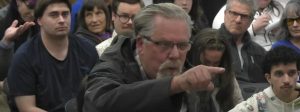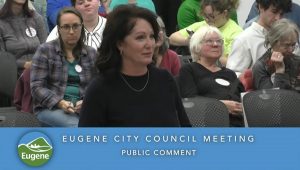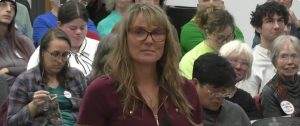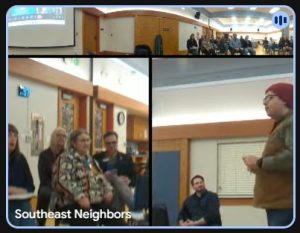River Road builds preparedness team, even during a pandemic
6 min read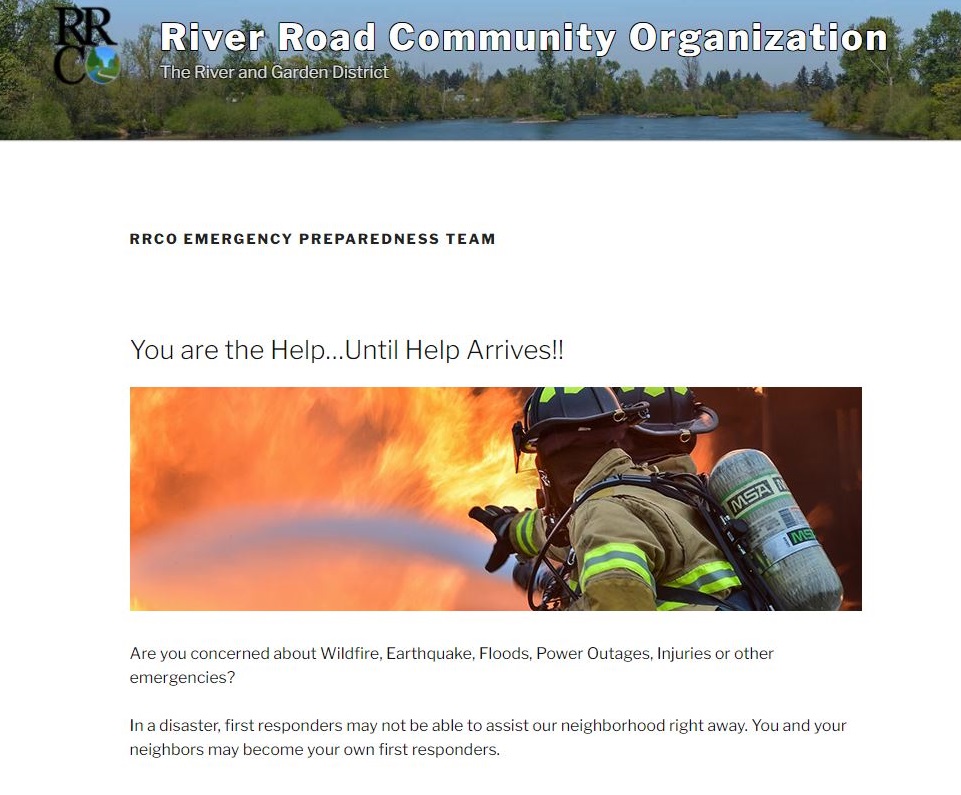
River Road residents met outdoors and followed public health guidelines to build Map Your Neighborhood teams during the pandemic.
Even during the pandemic, the River Road Community Organization continued building its emergency preparedness team. Jacque Wurster and Charlsey Cartwright spoke at a monthly meeting this spring.
Jacque Wurster: [00:00:12] My name is Jacque Wurster. After the pandemic and the wildfires of last year, we know that it is absolutely essential that we get prepared and help one another as a community. During an emergency or a natural disaster, first responders may not be able to assist us right away. You and your neighbors may end up providing food, water, shelter, or medical care to each other before outside help arrives.
We gather once a month to share information, organized resources and, really importantly, plan events for our neighbors. The goal here is to create experiential events for our neighbors, where we can get hands-on experience with the specific skills that we’re talking about. We can send out a hundred emails with different links to resources, but it’s really the live action events that are going to make that information stick for everybody. So we want to be able to hold more of those to share that information.
John Q [00:01:01] For example, last Saturday, the River Road group practiced with emergency radios.
Thank you for supporting
local citizen journalism
Jacque Wurster: [00:01:07] The emergency radio communications field day, which is at the Irving Grange in Santa Clara, it’s targeted for people from the River Road, Bethel, and Santa Clara areas. This event will include ham, FRS and GMRS radio usage.
FRS radios have a short range about a mile or less, and they don’t require a license. So these are small handheld walkie talkie looking radios that you could buy it at Bi-Mart or home Depot or any other hardware store. And the idea for this event is that in the event of a disaster, neighbors would organize, assess the damage near them, and then use these FRS radios to communicate with each other.
And then eventually with local ham radio operators who would get in touch with the city’s emergency operations center or 911, and then the emergency operation center would use that information to prioritize where to send emergency resources. So with that, I will pass it to Charlsey.
Charlsey Cartwright: [00:02:00] Thank you, Jacque. My name is Charlsey Cartwright. Let’s talk about the premise of Map Your Neighborhood. In a disaster, your most immediate source of help are your immediate neighbors living around you. Most commonly 15 to 20 houses built in close proximity to one another would get together to start a map, your neighborhood effort.
They would learn the nine steps to take immediately following a disaster, to secure your home and protect your neighborhood. They would identify the skills and equipment each participating neighbor has that could be useful in a disaster. The group would create a neighborhood map, identifying the location of natural gas and propane tanks that could be turned off quickly in case of disaster. They would create a contact list and identify those residents in their group with special needs, such as the elderly persons with disabilities, children, pets that may be home alone when a disaster which strike. And they would work together as a team to evaluate their neighborhood during the first hour, ideally following a disaster and take necessary actions.
Growing your Map Your Neighborhood is a very bonding experience. It’s an opportunity for neighbors to get to know one another. And sometimes that is for the first time. Traditionally those meetings of map your neighborhood groups take place in people’s homes, and that would be difficult to be safe with regards to COVID-19. But, what I would like to share with you is what we’ve done on Norman Avenue, which is where I live. And the way this unfolded was very informally and very safely, I was in a conversation several months ago with a neighbor across the street. And we were talking about the possibility of starting this group. Over a number of a couple of weeks there were more conversations on the street with neighbors passing by and phone calls and emails. And it started to grow. People were very interested and concerned. I used Google maps and developed this map here and numbered the houses in a way that’s recommended by the Map Your Neighborhood program. We created a contact list, which is confidential. We only share it amongst ourselves, and we identified a place called an emergency meeting place, which is in yellow, in the middle of the neighborhood and actually a second alternate meeting place right across the street.
Down the line, we will probably need to identify a house in which the vulnerable in case of emergency can be safely cared for. Out of the 21 houses that I have illustrated on this map, 11 are currently signed up to be part of the team. And I have no doubt that will increase rather easily, especially as we get beyond COVID-19.
It feels like a huge achievement considering that it’s only been a few months since this started and also considering the isolation of the pandemic.
It’s been such a gratifying experience. People here are very private. They don’t tend to engage that much, but invariably on this subject, It seems like a lot of people have been touched by disaster and in one form or another, and it’s a worry for them. And I think that there’s a sense of relief when somebody says you don’t have to be alone in this.
I’d really encourage the people at this meeting to consider starting a map your neighborhood group in your area. And if you already have one please do let us know so we can share ideas and help one another with the formation of more groups. Thank you very much.
Jacque Wurster: [00:06:17] Thank you, Charlsey. So up next is talking about CERT. You may have seen this acronym, CERT stands for Community Emergency Response Team and the training for this team consists of in-person classroom instruction, group activities to work through disasters on paper, and then hands-on learning to practice the skills that you’ve learned.
At the end of all of those classes, there’s a live disaster simulation where you get to put your skills into use and you do things like assessing building damage to determine if it’s safe to access searching and rescuing for victims that may be inside rescuing trapped victims from falling debris, learning how to lift something heavy off of somebody. Fire suppression using both a firehose and a fire extinguisher, and if you’ve never used, you never discharged a fire extinguisher before. This was really great practice. And then finally, you also practice medical triage, basic first aid and bleeding control.
Personal safety is one of the most important rules of training. You cannot help another person if you are injured yourself. And we don’t want to add to the list of victims for first responders to attend to. So it’s always very important to assess the situation and make sure that it’s safe for yourself first.
With the CERT training, there’s no specific obligation to be a lifelong member and rescue every person in your neighborhood. But the skills and the knowledge that you learn in this program are really invaluable to personal and immediate family safety. And lessons that you learn, like assessing the situation, making a plan, executing the plan, re-evaluating that plan. They all mentioned planning in some way.
They apply to a lot of aspects of life outside of emergencies. And this program really taught me skills to remain more calm when I’m up against something unexpected. Due to the nature of this in-person training, the local cert training classes have been paused due to COVID. But there are online courses that are becoming available and the local start organization is actively researching the best way to gain access to that and facilitate that for the Eugene.
It’s becoming clear that we are the foundation to this effort. You’ll see individual preparedness, that is the foundation of all of this, and then working together with our immediate neighbors, like the Map Your Neighborhood program that would be neighborhood preparedness, and then eventually partnering with our larger community to create a plan to survive and recover.
John Q: [00:08:29] Contact your neighborhood organization to connect with preparedness efforts near you.
